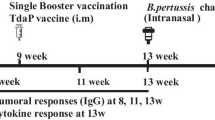Abstract
-
▲ Boostrix® US formulation (hereafter referred to as Tdap) is a formulation of reduced-antigen, combined diphtheria-tetanus-acellular pertussis vaccine, adsorbed onto aluminium approved in the US for use as a single-dose booster immunization in adolescents aged 10–18 years.
-
▲ The diphtheria and tetanus toxoid components of Tdap elicited serologic immune responses comparable to those induced by an approved diphtheria-tetanus (Td) booster vaccine in a large (n = 4114), randomized, observer-blind, multicenter, pivotal trial in US adolescents aged 10–18 years.
-
▲ In addition, antibody levels against pertussis antigens (pertussis toxoid, filamentous hemagglutinin, and pertactin) induced by Tdap were non-inferior to, and numerically higher than, those induced in infants who completed a three-dose primary immunization course with combined diphtheria-tetanus-acellular pertussis vaccine (Infanrix®), which conferred 89% protection against pertussis.
-
▲ Tdap had a similar reactogenicity profile, including solicited local reactions and general symptoms, to that of the approved Td vaccine in the pivotal US study. In particular, Tdap was similar (non-inferior) to Td with respect to the primary safety endpoint, namely the incidence of grade 3 pain at the injection site within the 15-day post-vaccination period.
-
▲ No serious adverse events of potential autoimmune origin or of a new-onset, chronic nature were reported during the 6-month post-vaccination period in the pivotal US study and a smaller (n = 319) German-based trial that also evaluated Tdap.


Similar content being viewed by others
Notes
The use of trade names is for product identification purposes only and does not imply endorsement.
References
Centers for Disease Control and Prevention. Preventing tetanus, diphtheria, and pertussis among adolescents: use of tetanus toxoid, reduced diphtheria toxoid and acellular pertussis vaccines. Recommendations of the Advisory Committee on Immunization Practices (ACIP). MMWR Morb Mortal Wkly Rep 2006 Feb 23; 55: 1–45
Tan T, Trindade E, Skowronski D. Epidemiology of pertussis. Pediatr Infect Dis J 2005 May; 24 (5 Suppl.): S10–8
Verstraeten T. Pertussis vaccine recommendations in the era of acellular vaccines. Expert Rev Vaccines 2005 Apr; 4(2): 163–5
Edwards K, Freeman DM. Adolescent and adult pertussis: disease burden and prevention. Curr Opin Pediatr 2006; 18: 77–80
Cherry JD. The epidemiology of pertussis: a comparison of the epidemiology of the disease pertussis with the epidemiology of Bordetella pertussis infection. Pediatrics 2005 May; 115(5): 1422–7
Mitka M. Age range widens for pertussis vaccine: boosters advised for adolescents and elderly. JAMA 2006 Mar 6; 295(8): 871–2
Centers for Disease Control and Prevention. Pertussis surveillance report: 8/12/05 (final data). Atlanta (GA): Bacterial Vaccine Preventable Diseases Branch, National Immunization Program, Centers for Disease Control and Prevention, 2004
Forsyth KD, Campins-Marti M, Caro J, et al. New pertussis vaccination strategies beyond infancy: recommendations by the Global Pertussis Initiative. Clin Infect Dis 2004 Dec 15; 39: 1802–9
Lee GM, Lett S, Schauer S, et al. Societal costs and morbidity of pertussis in adolescents and adults. Clin Infect Dis 2004 Dec 1; 39(11): 1572–80
Centers for Disease Control. Diphtheria, tetanus, and pertussis: recommendations for vaccine use and other preventive measures: recommendations of the Immunization Practices Advisory Committee (ACIP). MMWR Morb Mortal Wkly Rep 1991: 40(RR-10): 1–28
Tan T, Halperin S, Cherry JD, et al. Pertussis immunization in the global pertussis initiative North American region: recommended strategies and implementation considerations. Pediatr Infect Dis J 2005 May; 24 (5 Suppl.): S83–6
Purdy KW, Hay JW, Botteman MF, et al. Evaluation of strategies for use of acellular pertussis vaccine in adolescents and adults: a cost-benefit analysis. Clin Infect Dis 2004 Jul 1; 39(1): 20–8
Lee GM, Lebaron C, Murphy TV, et al. Pertussis in adolescents and adults: should we vaccinate? Pediatrics 2005 Jun; 115(6): 1675–84
Centers for Disease Control and Prevention. Recommended childhood and adolescent immunization schedule: United States, 2005. MMWR Morb Mortal Wkly Rep 2005 Jan 7; 53: Q1–3
Centers for Disease Control and Prevention. Recommended childhood and adolescent immunization schedule: United States, 2006. MMWR Morb Mortal Wkly Rep 2006 Jan 6; 54: Q1–4
Centers for Disease Control and Prevention. ACIP votes to recommend use of combined tetanus, diphtheria and pertussis (Tdap) vaccine for adults [online]. Available from URL: http://www.cdc.gov/nip/vaccine/tdap/tdap_adult_recs.pdf [Accessed 2006 Mar 10]
Chapman TM, Goa KL. Reduced-antigen combined diphtheria-tetanus-acellular pertussis vaccine (Boostrix®). Drugs 2003; 63(13): 1407–13, discussion 1415-6
FDA talk paper. First combination vaccine approved to help protect adolescents against whooping cough [online]. Available from URL: http://www.fda.gov [Accessed 2005 May 5]
FDA talk paper. FDA approves a new combination vaccine to help protect both adolescents and adults against whooping cough [online]. Available from URL: http://www.fda.gov [Accessed 2006 Mar 17]
Pichichero ME, Blatter MM, Kennedy WA, et al. Acellular pertussis vaccine booster combined with diphtheria and tetanus toxoids for adolescents. Pediatrics 2006 Apr; 117: 1084–93
GlaxoSmithKline. Boostrix® (tetanus toxoid, reduced diphtheria toxoid and acellular pertussis vaccine, adsorbed) prescribing information. Research Triangle Park (NC): GlaxoSmithKline, 2006
Schwartz AT. FDA clinical briefing document for GlaxoSmithKline Biologicals tetanus toxoid, reduced diphtheria toxoid and acellular pertussis vaccine, adsorbed Boostrix® [online]. Available from URL: http://www.fda.gov [Accessed 2006 Feb 27]
Theeten H, Van Damme P, Hoppenbrouwers K, et al. Effects of lowering the aluminium content of dTpa vaccine on its immunogenicity and reactogenicity when given as a booster to adolescents. Vaccine 2005; 23: 1515–21
Schmitt HJ, Schuind A, Knuf M, et al. Clinical experience of a tricomponent acellular pertussis vaccine combined with diphtheria and tetanus toxoids for primary vaccination in 22,505 infants. J Pediatr 1996 Nov; 129(5): 696–701
Minh NNT, He Q, Ramalho A, et al. Acellular vaccines containing reduced quantities of pertussis antigens as a booster in adolescents. Pediatrics 1999 Dec; 104(6): e70–5
Author information
Authors and Affiliations
Corresponding author
Rights and permissions
About this article
Cite this article
Frampton, J.E., Keam, S.J. Reduced-Antigen, Combined Diphtheria-Tetanus-Acellular Pertussis Vaccine, Adsorbed (Boostrix® US Formulation). Pediatr-Drugs 8, 189–195 (2006). https://doi.org/10.2165/00148581-200608030-00005
Published:
Issue Date:
DOI: https://doi.org/10.2165/00148581-200608030-00005




